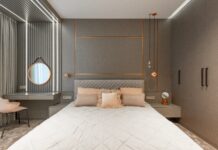3D Architectural Rendering and Visualization have become an integral part of the architecture in the past few years. With the help of 3D Rendering and Visualization tools, architects, designers, and 3D artists can instantly modify their ideas, moving back and forth between the abstract and the tangible, testing out many iterations, and ultimately arriving at the best possible outcome.
What is 3D Visualization?
Combining aesthetic and technological expertise, 3D Visualization or 3D modeling is used to showcase visuals of, or renders of, things that have not yet been released to the public. The most difficult part of the production process is designing the product.
Following are just a few of the many processes required to complete the design process:
- Prototyping
- Modelling
- Analysis of manufacturability
- Market study
- Sketching,
- Concept design, and creativity
These digitally processed computer renderings of product design encompass the finest details. The end product is an interactive digital picture that fully submerges the viewer with the content it displays.
Colors, materials, measurements, forms, and much more are all included in the information. 3D Visualization is the procedure whereby specified items and objects are rendered in 3D, utilizing specialist software.
What is 3D Rendering?
Although technically more advanced, 3D Rendering lacks the aesthetic appeal and immersiveness of 3D Visualization. Creating a 3D model is the first step in the 3D rendering process. Creating an image that seems as close to real life as possible is the primary focus of 3D Rendering.
The need for top-tier, photorealistic 3D architectural rendering services is at an all-time high. 3D Rendering, in its most basic form, is the act of converting a 3D model into a 2D picture.
Three-dimensional commercial rendering places far higher demands on system resources than creating a video or still picture. This three-dimensional image must accurately depict the real thing, including its surroundings.
BENEFITS OF 3D RENDERING AND VISUALIZATION
- Enhances Communication
3D models and visualizations may enhance communication by accurately representing ideas and concepts, which is particularly helpful when working with teams in various places. When team members see a depiction of the project they are working on, it inspires further cooperation. Accurate models and graphics may also aid in increasing comprehension and understanding. It is extremely effective for explaining complex topics or thoughts to others.
- Increased Creativity
3D Visualization also promotes creativity by enabling users to experiment with various design options. For interior designers, architects, theatrical set designers, and event organizers, 3D renderings and models are the ideal options for creating an exact picture of their concept, which can then be utilized as a virtual environment for planning.
- Improved Decision-Making
3D Visualization may assist you in making better choices by enabling you to examine many possibilities and situations. It is particularly useful in disciplines like architecture and engineering, were making the proper choice may significantly influence the end output.
It may also aid your client’s decision-making process. Clients can better comprehend design alternatives with 3D designs than with 2D drawings. 3D models allow people to see how the completed product will fit into its surroundings. It also enables customers to feel the space offered by design rather than waiting for construction to be completed.
- Impactful Presentations
Presentations using 3D graphics may be fascinating and engaging. It may help you clarify your thoughts and make them more understandable. 3D visuals are also more aesthetically attractive, which might assist in keeping your audience’s attention on your presentation.
3D Visualization is a technique for creating 3D representations of things or situations. These models may be used to teach ideas or to show how processes work. 3D graphics also be used to generate animations that demonstrate how something works or should operate. Animations may assist you in simply explaining complicated topics.
Civil engineers also develop visual experiences using 3D Rendering and Visualization. It lets them assess and convey real-world designs while providing customers with good civil engineering services.
- Economic Benefits
This program allows you to experiment with new thoughts and ideas without worrying about time or money. It also lets you preview what the end product will appear like from many perspectives before any realistic drawings are generated, saving you time and money!
3D Visualization also assists company owners in creating cash flows before the creation of a product. Many consumers insist on viewing the final product before making a purchase, which isn’t always possible, particularly for house designers or event planners. 3D Visualization gives your consumers a sense of the product before it is created.
3D Visualization is very useful for showing prospective investors or purchasers your items. It enables third-party corporations to generate money before investing. Interactive displays are an excellent approach to developing a new idea since they enable merchants to engage with the product, try out different features or use cases, and play movies displaying various capabilities.
Conclusion
3D Visualization and 3D rendering technology are clearly on the rise and in a constant state of change. New developments are being adopted, and the technology is used in various industrial areas. The reality is that these strategies will assist us in developing better structures and buildings that will withstand the test of time. This cutting-edge design technology has several advantages, including greater communication, creativity, improved decision-making, successful presentations, and financial advantages. It will be fascinating to see how 3D Visualization and 3D Rendering take over in the next years and improve many businesses’ productivity.


























